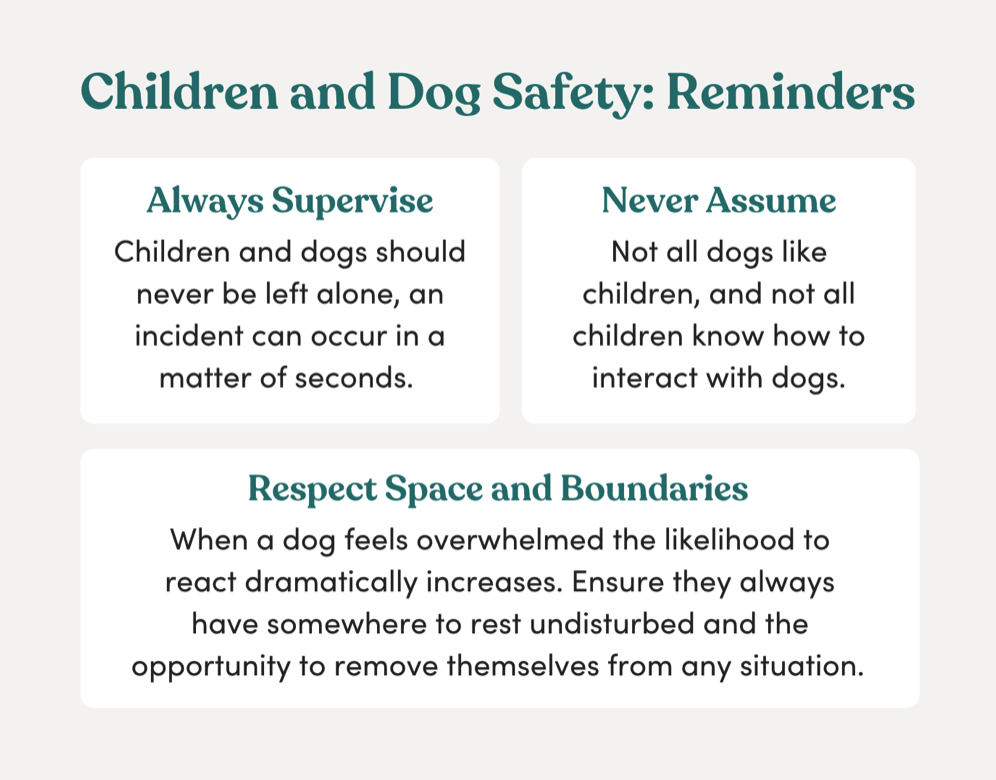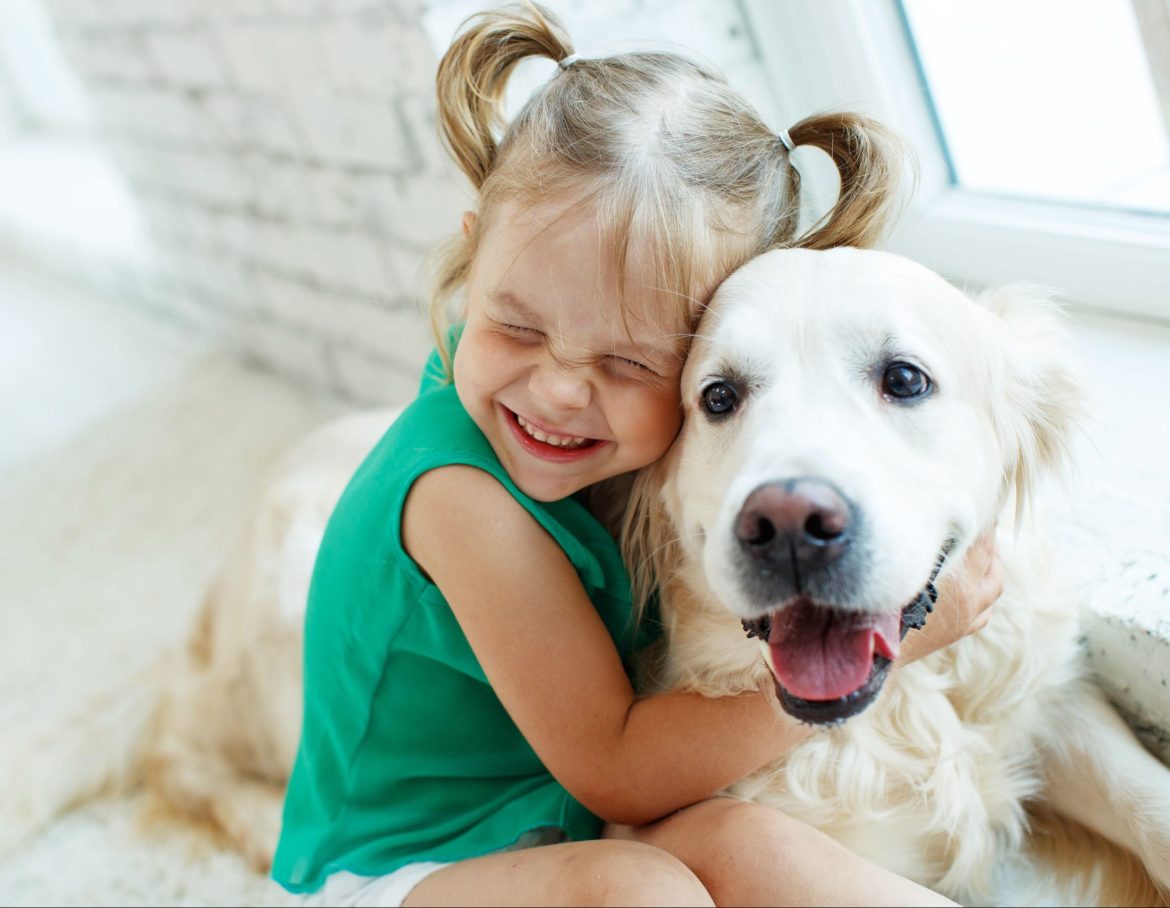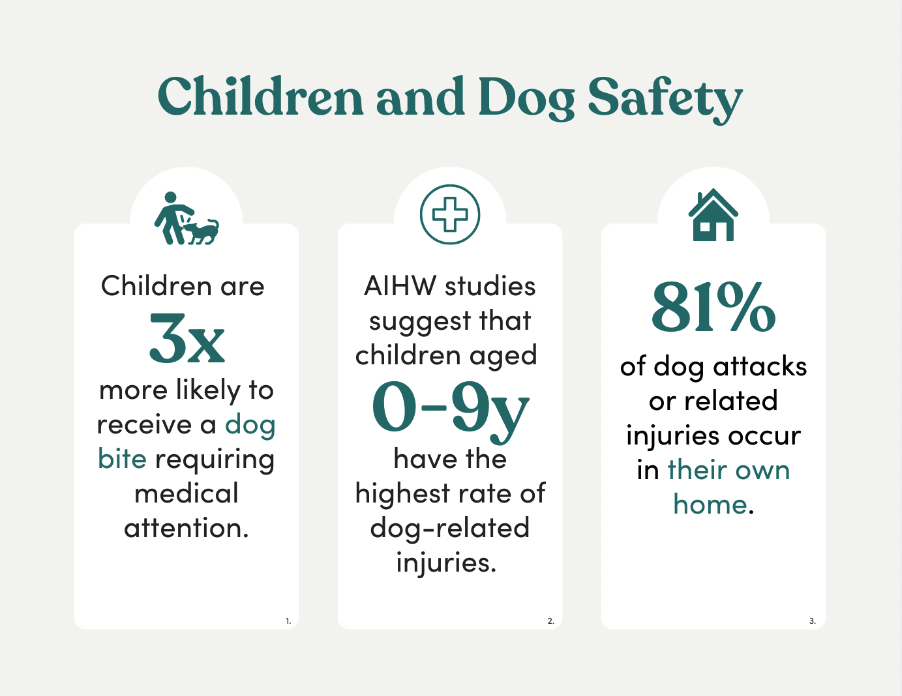Children and dogs can form wonderful bonds that provide companionship and teach valuable life lessons. However, it is crucial to prioritise safety when allowing these interactions to ensure the well-being of both the child and the dog. As the primary carer for a dog and or child it is your responsibility to manage their interactions to ensure that it remains a positive and safe experience at all times.
Ensuring safety is the priority when children and dogs interact
Unfortunately, children are most at risk to receive injuries from pets and the majority of incidents relating to children and pets are preventable. The key preventative tool is supervision, ensuring that there is an adult to supervise and intervene when necessary will decrease the likelihood of an incident occurring.
Although it’s vital that pet owners understand their pet and their arousal levels, educating children on boundaries with pets is the second most important tool for preventing incidents. No child is ever going to be bulletproof when it comes to interacting with pets which is why supervision will always be necessary.
Key safety boundaries to teach children when they’re around dogs
- No pulling: Tails, ears, legs, whiskers or any other body parts are not toys and can startle a dog when pulled at, even when not causing pain.
- No hugging or kissing: Dogs communicate through body language and theirs is very different to ours. A dog doesn’t understand being smothered in hugs and kisses so it can be uncomfortable, frustrating and scary for them.
- No chasing: Whilst chase is a game that dogs play with each other, it often leads to play nips and tumbles.
- No holding down: Pinning down or holding back a dog will build extreme frustration and fear so should never be tolerated.
- Gentle petting: Teach children how to pet dogs, short soft pets on the chest back and bum.
- Areas to avoid: Dogs don’t like to be pet on the top of the head or surprised from behind so make sure they’re aware of the children’s whereabouts before interacting.
- Gentle vocals: Dogs’ hearing is much better than humans so screaming, squealing and loud noises are much more startling for them so it’s best to teach kids to maintain a calm low volume.
- 10 seconds and wait: Dogs don’t enjoy non-stop attention so as a rule of thumb teach children to pet or interact with the dog for 10-15 seconds and pause to see if the dog seeks more attention or doesn’t. Only when the dog seeks more attention should they continue, and then repeat the process until the dog has had enough.
- Only when asked: Similar to the 10-second rule, it’s important to teach children to only interact with the dog when the dog asks for it. Overwhelming the pet by constantly disturbing them can be extremely problematic.
- Sleeping and eating: Dogs should always be left alone when eating or sleeping. Letting children interrupt them can lead to resource guarding.
- Space: Ensure there is an ‘out of bounds’ space where the pet can go to get some alone time where the children aren’t allowed. A dog’s bed should be considered a place of safety and sanctuary for them.
- Not sharing food: Dogs can get quite sick from human food and it might be hard for children to differentiate what they can and cannot have so it’s best to put in a ‘no sharing human food’ rule.
- Sudden movements: Jumping, running or other sudden movements can startle a dog or initiate a prey drive which will start a game of chase so it’s best to keep kids calm around dogs.
- Always ask: Teach children to always ask the owner or supervising adult if they’re allowed to pet the dog before doing so.
Regardless of how well they know each other an incident between a dog and a child can always occur, it only takes a matter of seconds for something to go wrong. This is because not every nip, growl, bark or bite comes from malicious intent.
Most of the time aggressive behaviour will come from fear with no real intention of causing harm but in an attempt to create space from whatever is triggering them. This reinforces the need to teach children to respect their boundaries to avoid them resorting to aggressive behaviour to seek space.
Top safety tips to remember when letting children and dogs interact:

Teaching children boundaries with dogs is crucial to safe interactions however, the responsibility for everyone’s safety is your responsibility. This means that you should always take responsibility for the dogs and not let children do things such as hold the lead, feed the pet or assume any other responsibility for other people’s pets in your care.
Further reading:
How do I introduce my dog to children?
Why pets are good for kids
How to introduce kids to dogs
__________________________________________________
Article sources:
1. Kidspot
2. AIHW
3. Kidsafe


